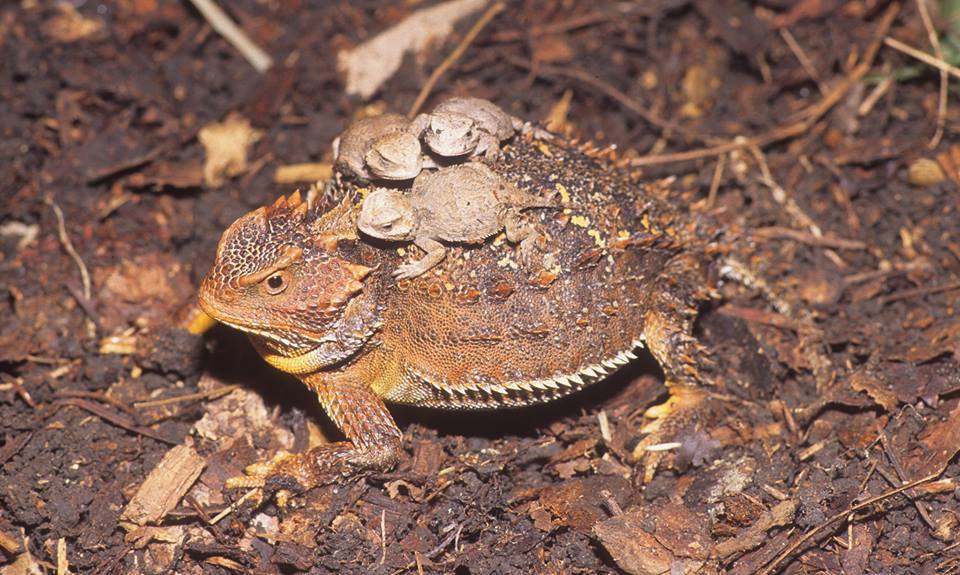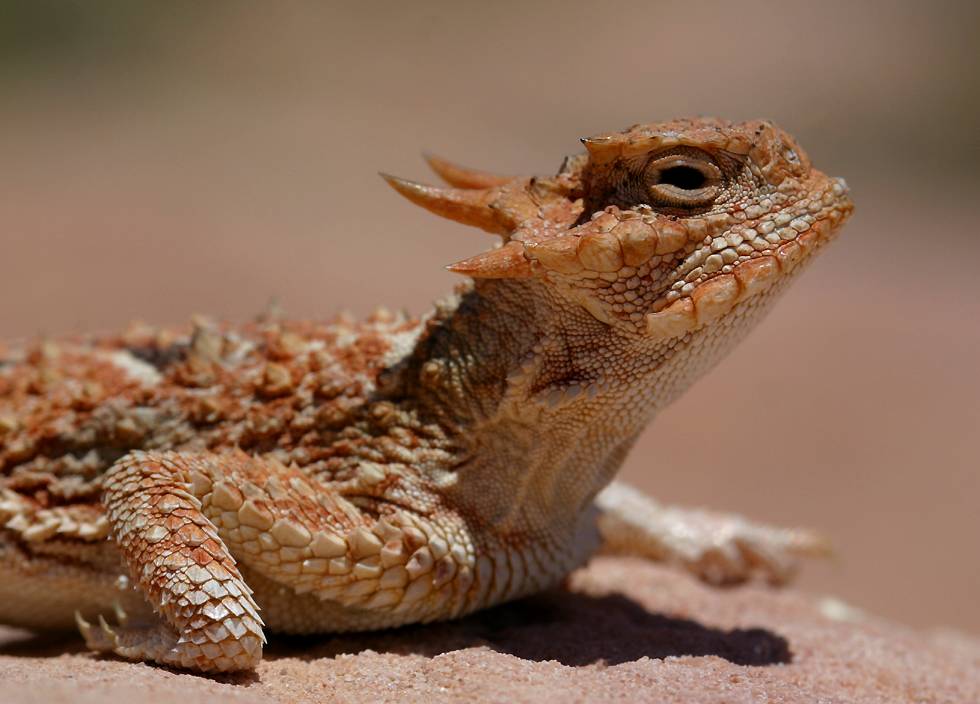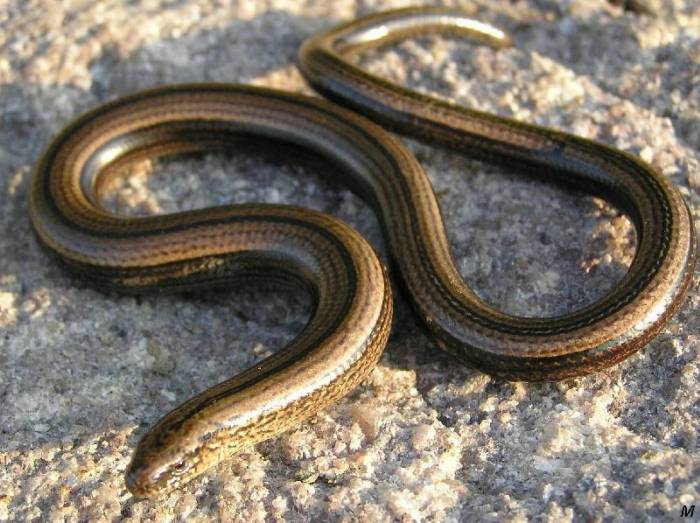 |
| Adder giving birth to live young. |
Ovoviviparous is the term used for reptiles that give birth to live young, which only represents about 20 percent of the modern scaled reptile population. Ovoviviparous species are similar to viviparous species in that there is internal fertilization and the young are born live, but differ because the young are nourished by egg yolk, as there is no placental connection. Most reptiles give birth to live young, but there are some reptiles that do have placenta like structures capable of transferring nutrients and are therefore considered viviparous like mammals.
One example would be the skink. Skinks are lizards belonging to the family Scincidae and the infraorder Scincomorpha. In fact, forty-five percent of skink species are viviparous with many others being ovoviviparous, although some do lay eggs. Many species of skink produce young that derive their nourishment from a mammal-like placenta attached to the female, which is often referred to as viviparous matrotrophy. However, in skinks, placental development is considered phylogenetically analogous rather than homologous to functionally similar processes in mammals. Analogous describes the relation between characteristics in organisms that are apparently similar yet phylogenetically independent. This means that although two separate species may have physical structures performing a similar function, their origin evolved independently and formed from a different evolutionary line.
In contrast, homology is the existence of shared ancestry between a pair of structures or genes in different species that can adapt to different purposes as the result of descent with modification from a common ancestor. This means that skinks and mammals did not develop their congruent structures (e.g. placental connections) from a recent common ancestor, but developed the feature independently through convergent evolution. Convergent evolution is the independent evolution of similar features in species of different lineages resulting in symmetrical physical structures and limbs. Although it could be argued that a true form of convergent evolution may not exist on Earth, because all terrestrial life forms share common ancestors that can be traced back to Earth's earliest single-celled organisms.
 |
| Blue-tongued skink mother giving birth to live young. |
Nearly a hundred reptile lineages have independently made the transition from egg-laying to live birth in the past, and ancient reptiles seem to have switched back and forth between these two birthing strategies around 175 million years ago before most finally settled on egg-laying. It seems temperature was one of the main causes of this flip-flopping, because colder conditions encourages the females to retain their eggs for longer and longer periods of time. Colder temperatures seem key to triggering the switch to live births, or so says the authors of a new study that used genetic sequencing to explore the birth history of around 2,000 species of lizards and snakes.
The researchers stated, "These results suggest that parity mode is a labile trait that shifts frequently in response to ecological conditions." The report also revealed that it has found, "strong support for an early origin of viviparity at the base of Squamata, and a complex pattern of subsequent transitions."Before this, researchers assumed that lizards and snakes (Squamata) did not go back to egg-laying after making the shift to live birth. One doctor who published another study on viviparous populations of skinks also commented on the subject.
Dr Sarah A Smith observed that, "The geographic distribution of reproductive modes within these scincid lizards (skinks) supports the major perdition of the "cold climate" hypothesis for the evolution of viviparity. Viviparous taxa occur in colder areas than their closest oviparous relatives, a pattern evident in the comparison between oviparous and viviparous populations."
In fact, skinks are almost unique today in being halfway through their evolution towards live birth. Halfway through their evolution in that some lay eggs while those that dwell in colder climates often produce through live birth. The yellow-bellied three-toed skink can lay eggs, but individuals of the same species living in the colder mountain regions almost always give birth to live young. It seems that even though this species can lay eggs, they still retain their ability to produce with live birth and can switch back and forth. James Stewart, a biologist at East Tennessee State University, believes that the dual behavior of the yellow-bellied three-toed skink offers scientists a rare opportunity to study a long evolutionary timeline that is still in the process of changing and evolving.
"By studying differences among populations that are in different stages of this process, you can begin to put together what looks like the transition from one [birth style] to the other." said Stewart.
 |
| A yellow-bellied three-toed skink carrying embryos, visible as orbs inside its body. |
The results suggest that the move from egg-laying to live birth in reptiles could have been fairly common in prehistoric eras, and it could still be quite easy for some modern reptiles to make the switch.
"We tend to think of this as a very complex transition," Stewart said, "but it's looking like it might be much simpler in some cases than we thought."
Despite this, reptiles that give birth to live young are actually quite rare in this modern era, as only 20 percent of reptiles actually display this ability, but could many more examples exist undiscovered because their lack of proximity to colder climates? One way to test this theory may be to artificially expose various forms of reptiles to slightly colder climates for long periods of time, and simulate a mountainous environment with colder temperatures and higher, drier altitudes to observe if any eventually switch to live-birthing. We may not know if more reptile species retain the ability to make switch until a reputable study is performed and published by a respected journal.
So which was first, egg lying or live birthing? Similar to the question, "Which came first, the chicken or the egg?" Maybe studying some of these live-birthing reptiles can help us answer that question. We know that some reptiles that usually lay eggs can switch to live births, and this would imply that egg lying came first. Although, surprisingly, a reputed study published in Ecology Letters reveals evidence to the contrary. The study states that the first reptiles likely gave birth to live young, evolving over time to lay eggs. It also states that certain lineages of lizards and snakes probably switched back and forth between the two several times over a span of millions of years.
Apparently, some species of skink still are making the switch from live-births to egg lying and back again, as it is with the case of the yellow-bellied three-toed skink. According to the study, one researcher, Pryon, reached this conclusion after closely analyzing the squamate evolutionary tree - in which lizard and snake species are categorized using DNA sequencing of thousands of samples from various lizards and snakes. The study reports that although most modern species of lizards and snakes lay eggs, almost all of these species branch off from the same live birthing ancestors that lived up to 175 million years ago. This theory is also supported by recently discovered fossil evidence, as well as the fossil records of lizards from the Cretaceous period. These records indicate that the majority of the ancestors of snakes and lizards were live-birthing creatures who adapted to lay protective eggs in warmer conditions, only to adapt again and again for live birthing or egg lying depending on ecological conditions.
Apparently, some species of skink still are making the switch from live-births to egg lying and back again, as it is with the case of the yellow-bellied three-toed skink. According to the study, one researcher, Pryon, reached this conclusion after closely analyzing the squamate evolutionary tree - in which lizard and snake species are categorized using DNA sequencing of thousands of samples from various lizards and snakes. The study reports that although most modern species of lizards and snakes lay eggs, almost all of these species branch off from the same live birthing ancestors that lived up to 175 million years ago. This theory is also supported by recently discovered fossil evidence, as well as the fossil records of lizards from the Cretaceous period. These records indicate that the majority of the ancestors of snakes and lizards were live-birthing creatures who adapted to lay protective eggs in warmer conditions, only to adapt again and again for live birthing or egg lying depending on ecological conditions.
“With squamates, the question that Frank and I tossed around was, how does viviparity evolve? We went into it with the classic assumption that it evolved 115 times. We were blown away by this novel result, that it originated much earlier; and it would have been impossible to know this without a large-scale tree of life.” stated Pyron.
 |
| Mounted fossil of Polycotylus latippinus, a pregnant plesiosaur, from 78 million years ago. |
Here is a list of 5 modern reptiles that give birth to live young:
#1 Viviparous Lizard
The viviparous lizard or common lizard was formerly classified as Lacerta vivipara but is now the only species in the monotypic genus Zootoca (Zootoca vivipara.) It is a Eurasian lizard and lives farther north than any other reptile species and most populations are viviparous (giving birth to live young) rather than laying eggs as most lizards do. Like the yellow-bellied three-toed skink most northern examples of the vivparous lizard give birth to live young, while some southern populations are oviparous (egg-laying).
Interestingly, individuals from viviparous and oviparous populations may be hybridized, but with significant embryonic malformation. The offspring develop for three months inside the female and they do develop placenta to facilitate pregnancy, but there is no substantial transport of nutrients as seen in some other species of viviparous reptiles.
 |
| Viviparous lizard giving birth to live young. |
There are some specifically distinct populations of the Viviparous lizard that could be threatened or endangered, although they are categorized as a "Least Concern" in Switzerland. Other than Switzerland this species is widely distributed throughout Europe and Asia, and its range even extends to the north of the Arctic Circle. In the southern parts of its distribution range the species lives at high elevations, occurring as high as 9,800 ft above sea level in the Alps. Despite being threatened, in some areas of the UK’s the Viviparous lizard is the most common and widespread reptile. Additionally, it is the only reptile native to Ireland.
#2 Phrynosomatidae lizards
A study on Phrynosomatidae lizards solves the 30 year old question of, "If the cold climate hypothesis is true then why do some tropical lizards and snakes bear live young?" The study shows that tropical live-bearers hail from high elevations—where it can get cold—and suggests that this reproductive strategy in reptiles may often originate on tropical mountainsides. A graduate student at the University of Arizona in Tucson, Shea Lambert, scanned the scientific literature for the reproductive styles of 117 Phrynosomatidae lizards.
He decided to analyze the Phrynosomatidae lizards that included horned lizards and fence lizards because the species range from colder Canada to warmer Central America, and because viviparity has evolved six times in this group's past. The study revealed that viviparity, for this group, originated at high elevations in the lower latitudes near tropical regions and not in temperate regions. "Viviparity is favored in the tropics," Lambert stated. The two live-bearing lizards of this species live in tropical lowlands, but the family tree revealed that these species belong to lines that were once high-altitude dwellers. They eventually became live-bearing in these high altitudes, and then moved to the lowlands more recently. This suggests that higher altitudes, as well as colder weather conditions may influence the switch to live birth.
 |
| Greater short-horned lizard with young. (Note: The horned lizard can also shoot blood from its eyes in a projectile fashion when threatened.) |
#3 Southern Grass Skink
The Southern Grass skink is known as a model species for reproductive biology in reptiles because it gives birth to live young and it exhibits non-invasive epitheliochorial placentation. The Southern Grass skinks develop complex placenta which provides a substantial amount of nutrients to the embryo throughout pregnancy. Most other live-bearing reptiles do not develop a placenta at all, much less a complex placenta similar to those seen in mammals.
Unlike other live-bearing reptiles, in the Southern Grass skinks, the amount of nutrients provided to their developing young depends on the amount of food females consume during pregnancy. The scarcity of food during pregnancy can cause developmental failure, and when food is limited the females will also cannibalize their young. Together, these results suggest that placental nutrient transport may only be a successful mode of reproduction if food is abundant throughout pregnancy.
 |
| Late fetal stage in a Southern Grass Skink. |
The species was the first reptile observed with an extra-uterine pregnancy. The extra-uterine embryo did not invade maternal tissue, suggesting fundamental differences between the nature and evolution of placentation in the Southern Grass Skink and eutherian mammals.
 |
| Skink mother delivering live young. |
#4 The Adder
The adder is one example of an ovoviviparous reptile, which means that although they give birth to live young the babies actually develop within eggs stored inside the female. Another unusual trait for the adder is that the snakes are sexually dimorphic, which means that there are visual differences in each sex, something more commonly found in mammals or ancient mammal-like reptiles.
 |
| Two male adders courting one female. |
 |
| Newborn adder still in egg membrane. |
 |
| Female adder giving birth to live young. |
#5 Slow Worms
Anguis (slow worm) is a small genus of legless lizards (not snakes) in the family Anguidae, which has two described species. Both of these species give birth to live young and are oviviviparous. Slow worms can be distinguished from snakes by several features: their eyelids that can blink, which snakes lack entirely; their small ear openings which snakes also lack; and their tongues, which are notched in the center and only slightly forked.
The snake and the slow worm can both be considered animals that have reached comparable forms through convergent evolution, and are therefore analogous. They range across most of Europe and into parts of Asia, but are restricted to temperate and humid habitats. In the United Kingdom, the slow worm has been granted protected status alongside all other native British reptile species. The slow worm (Anguis fragilis) has been steadily decreasing in numbers, and under the Wildlife and Countryside Act 1981, it is illegal to intentionally injure, kill, or advertise with the intention to sell them.
 |
| Slow worm giving birth. |
 |
| Slow worm with young. |
Slow worms are also considered sexually dimorphic. The males of the species lose a stripe marking along their backs as they reach sexual maturity, at around 3 years of age. They normally live up to 30 years in the wild, and the record age for a slow worm in captivity is 54 years. The scales of the slow worm are smooth and do not overlap like most reptiles. Although like many other lizards they autotomize, meaning they can shed their tail which will grow back into a short stub.
5 Modern Reptiles That Deliver Young Through Live Birth, convergent evolution, grass snakes, lizards, Ovoviviparous, skink, slow worm, squamates, viviparity, viviparous, 5 Modern Reptiles That Deliver Young Through Live Birth, convergent evolution, grass snakes, lizards, Ovoviviparous, skink, slow worm, squamates, viviparity, viviparous, 5 Modern Reptiles That Deliver Young Through Live Birth, convergent evolution, grass snakes, lizards, Ovoviviparous, skink, slow worm, squamates, viviparity, viviparous, 5 Modern Reptiles That Deliver Young Through Live Birth, convergent evolution, grass snakes, lizards, Ovoviviparous, skink, slow worm, squamates, viviparity, viviparous, 5 Modern Reptiles That Deliver Young Through Live Birth, convergent evolution, grass snakes, lizards, Ovoviviparous, skink, slow worm, squamates, viviparity, viviparous, 5 Modern Reptiles That Deliver Young Through Live Birth, convergent evolution, grass snakes, lizards, Ovoviviparous, skink, slow worm, squamates, viviparity, viviparous, 5 Modern Reptiles That Deliver Young Through Live Birth, convergent evolution, grass snakes, lizards, Ovoviviparous, skink, slow worm, squamates, viviparity, viviparous, 5 Modern Reptiles That Deliver Young Through Live Birth, convergent evolution, grass snakes, lizards, Ovoviviparous, skink, slow worm, squamates, viviparity, viviparous,
5 Modern Reptiles That Deliver Young Through Live Birth, convergent evolution, grass snakes, lizards, Ovoviviparous, skink, slow worm, squamates, viviparity, viviparous, 5 Modern Reptiles That Deliver Young Through Live Birth, convergent evolution, grass snakes, lizards, Ovoviviparous, skink, slow worm, squamates, viviparity, viviparous, 5 Modern Reptiles That Deliver Young Through Live Birth, convergent evolution, grass snakes, lizards, Ovoviviparous, skink, slow worm, squamates, viviparity, viviparous, 5 Modern Reptiles That Deliver Young Through Live Birth, convergent evolution, grass snakes, lizards, Ovoviviparous, skink, slow worm, squamates, viviparity, viviparous, 5 Modern Reptiles That Deliver Young Through Live Birth, convergent evolution, grass snakes, lizards, Ovoviviparous, skink, slow worm, squamates, viviparity, viviparous, 5 Modern Reptiles That Deliver Young Through Live Birth, convergent evolution, grass snakes, lizards, Ovoviviparous, skink, slow worm, squamates, viviparity, viviparous, 5 Modern Reptiles That Deliver Young Through Live Birth, convergent evolution, grass snakes, lizards, Ovoviviparous, skink, slow worm, squamates, viviparity, viviparous, 5 Modern Reptiles That Deliver Young Through Live Birth, convergent evolution, grass snakes, lizards, Ovoviviparous, skink, slow worm, squamates, viviparity, viviparous,





